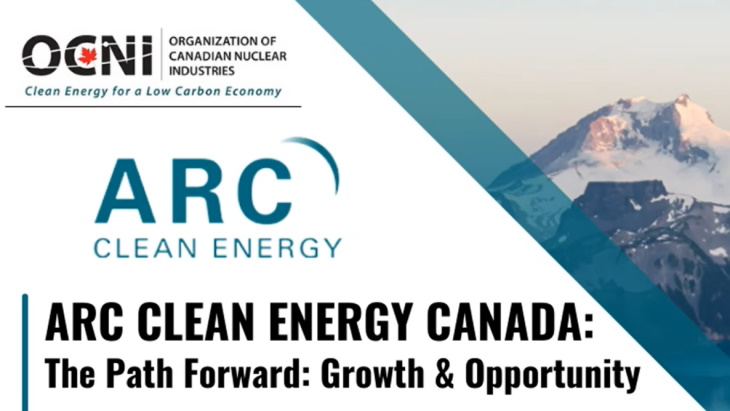ARC, along with NB Power and Moltex Energy, is part of an SMR vendor 'cluster' established in New Brunswick in 2020 with the aim of establishing an SMR supply chain in the province and deploying SMRs at NB Power's existing Point Lepreau site, which is currently home to a 660 MWe (net) Candu 6 reactor. The Government of New Brunswick earlier this year announced CAD20 million (USD16 million) in funding towards the advancement of the ARC-100 sodium-cooled fast reactor. The Government of Canada has also this year announced funding to advance the design of Moltex's Stable Salt Reactor - Wasteburner and WAste to Stable Salt (WATSS) facility, and has also announced funding for NB Power to prepare the Point Lepreau site for SMR deployment and demonstration, and to the University of New Brunswick to expand its capacity to support SMR technology development.
Also speaking at the OCNI event were Andy Hayward, director of advanced reactor development at NB Power, and Bill Cooper, vice-president of engineering at ARC, as well as New Brunswick Minister of Natural Resources and Energy Development Mike Holland. The event was chaired by OCNI President and CEO Ron Oberth.
The ARC-100 is a 100 MWe fast reactor that leverages proven technology developed at the Experimental Breeder Reactor-II (EBR II) sodium-cooled fast-reactor, which was developed at the US government's Argonne National Laboratory where it operated successfully for thirty years. The inherent safety characteristics and passive safety features of this design have already been proven, Hayward said. Currently, activities are focusing on preliminary design work, the VDR process, and development and preparation work at Point Lepreau, as well as progressing supply chain activities and First Nations and public engagement.
The timeline for ARC-100 commercialisation has been "accelerating", Labbe said. The first - Scoping - phase was completed in 2019; the second phase - Preliminary Design, which includes the second VDR phase, the completion of preliminary design work, validation of cost estimates and integrated schedule, as well as scoping fuel supply and manufacturing capabilities - is now under way and is expected to be completed by the end of 2023. Phase 3, which will include completion of the detailed engineering, procurement orders, construction permit licensing and approval, site preparation work and the execution of a construction contract, is scheduled to run until 2026.
The final - deployment - phase will run from 2027-2030, according to the timeline, and the company expects the first core to be delivered on site by the end of 2028, Labbe said. "I haven't seen anything in our schedule yet that moves us beyond [a 2029 operational date]", he added. "It's really coming down to a resource constraint at this point. Those are the types of things that we can manage."
"The other part is the regulatory approval. We need to have good quality documents, good discussions, good interface with regulatory agencies, and we need to make sure we provide them with everything that they need so that they can make decisions in a timely manner. That's a piece that's a little bit out of our control, but we can certainly set that stage very well with what we deliver, and that will enable our schedule to progress."
"We are in an envious position in New Brunswick, with the support of the New Brunswick government, a utility that has a long history of operating nuclear power plants, and a technology that's very mature and well proven," Cooper said. "This is an exciting time for SMRs and we don't have any obstacles in front of us that we can't get through to have one of these units up and running within the decade."





_23621.jpg)

_63865.jpg)
_18570.jpg)





